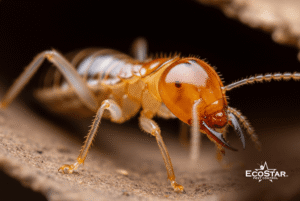Table of Contents
Walk into any busy warehouse in Texas, and you’ll see why ants love these spaces. Between open loading docks, shifting pallets, employee break areas, and plenty of hidden corners, it doesn’t take much for a colony to move in and spread fast. Once ants establish trails, they won’t pack up and leave. You need to deal with them.
In this guide, we’ll break down what attracts ants into warehouses, how to spot an infestation early, and the exact steps I recommend for getting rid of them and keeping them out.
Common Reasons Ants Infest Warehouses
No matter how clean a warehouse looks, ants can still find reasons to move in. Food crumbs, leaks, and even small gaps in the building are enough to draw them inside.
Let’s look at the most common factors that attract ants into warehouses.
Food debris and spills: Open snacks, messy packaging, and drink spills give ants an easy food source.
Moisture leaks: Roof drips, or plumbing issues.
Open entry points: Dock doors, wall gaps, utility penetrations, and floor joints.
Moving inventory: Cardboard, pallets, and boxes can carry crumbs or even ants themselves.
Outdoor colonies: Ant nests just outside the building often send foragers indoors.
Seasonal pressure: In hot Texas summers or heavy rains, ants head indoors for shelter.
Early Warning Signals of an Ant Infestation in a Warehouse
Don’t wait until you see hundreds of ants before taking action. A few clear signs include:
- Ant trails crossing pallets, floors, or beams.
- Small piles of dirt or frass near foundations or wall edges.
- Winged ants or discarded wings during swarm season.
- Ants repeatedly show up in the same areas as break rooms or loading docks.
- Heavy rains or extreme heat push ants indoors, as they look for dry, cool places like warehouses.
If you spot these signs early, it helps you control ants before they get out of hand.
Step-by-Step: How to Get Rid of Ants in a Warehouse
Here are the steps I recommend for eliminating ants from a warehouse.
1. Map and Inspect Key Zones
Start with a thorough inspection. Walk the building perimeter, check dock doors, foundation cracks, and utility lines. Inside, look around racks, pallet rows, and employee areas. Follow trails back to entry points or hidden nests.
2. Eliminate What’s Attracting Them
Clean up spills right away, especially sugary liquids or protein-based foods. Sweep under racking, mop break areas, and keep trash bins sealed. Fix leaks, control humidity, and move dumpsters away from the building.
3. Choose and Place the Right Bait
Ants don’t all eat the same thing. Some crave sugar, others prefer protein. Place non-repellent baits along trails and entry zones. Don’t spray over them, sprays break the trail and ruin the bait’s effectiveness. Rotate bait types if ants lose interest.
4. Use Complementary Treatments Where Needed
In some cases, baits alone aren’t enough. Apply liquid or granular treatments around the building exterior. Use foam or dust inside wall voids. Treat hot spots, but avoid repellent sprays that scatter ants and make the problem worse.
5. Seal, Reinforce, and Deter
Once activity is down, block the ways ants were getting in. Caulk foundation cracks, add door sweeps and strip curtains, and seal utility penetrations. Keep a buffer zone outside walls by trimming vegetation and pulling back mulch or soil.
6. Monitor, Assess, and Follow Up
Ant control isn’t a one-and-done job. Check bait stations regularly and adjust placement. Inspect the warehouse monthly or seasonally. Keep logs of activity so you know what’s working and when to rotate products.
Common Mistakes Warehouse Operators Make
Here are the errors I see most often when warehouses try to handle ants on their own:
- Spraying visible ants directly, which destroys bait trails.
- Setting baits in “clean” areas instead of along active trails.
- Using only one method (like a quick spray) instead of an integrated approach.
- Ignoring structural vulnerabilities like dock door seals.
- Waiting too long before calling the professional pest team.
How Soon Can You Expect Results and When to Call for Help
A small infestation might clear up in a week or two with proper baiting and sanitation. Larger colonies hidden deep in walls or soil can take weeks to fully collapse. If you’re not seeing progress after two or three weeks, it’s time to call professionals Ant pest expert.
Warehouse Pest Control Compliance & Best Practices
If your warehouse handles food or consumer goods, pest control isn’t just about comfort, it’s about compliance. Inspectors expect to see:
- Logs of pest control inspections and treatments.
- Staff trained to spot early signs of pests.
- Documented sanitation routines.
- An integrated pest management (IPM) plan.
Regular inspections with a licensed pest control provider help you stay ahead of both pests and audits.
Conclusion and Take-Action Checklist
Ants in a warehouse can quickly turn from a small nuisance into a big problem. By inspecting, cleaning, baiting, sealing, and monitoring, you can stop them from spreading.
Quick checklist you can start today:
- Walk the perimeter and check for entry points.
- Clean up food debris and repair leaks.
- Place baits along active trails.
- Seal cracks and improve door seals.
- Monitor and log ant activity weekly.
Stay consistent, and you can keep your warehouse running without ant problems. But if ants keep coming back, don’t wait, call EcoStar Pest Control at 214.774.4777 or email us at contactus@ecostarpestcontrol.com .


